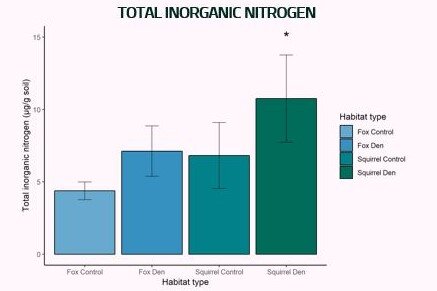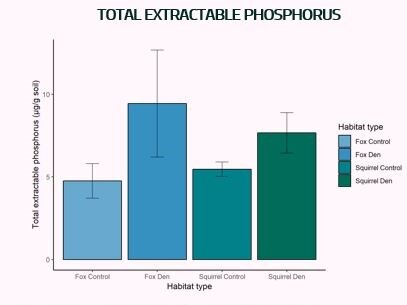Alexandria Martin
Age 17 | Winnipeg, Manitoba
Manitoba Schools Science Symposium 2019 Gold Award | Environmental Science 2019 Best Senior Level Project Engineers Geoscientists Manitoba 2019 Senior Level Award | Canada-Wide Science Fair 2019 Finalist
INTRODUCTION
Den creation can impact soil nutrient concentrations and ecosystem dynamics, particularly in regions with lower nutrient levels. Dens of terrestrial mammals can change plant diversity compared to the surrounding areas due to increased urine, feces, activity through digging, and decomposing prey or foraged food. For example, Gharajehdaghipour, Roth, Fafard and Markham (2016) found that dens of Arctic foxes (Vulpes lagopus) had greater nutrient concentration compared to control sites, specifically more inorganic nitrogen and extractable phosphorus. This has also been shown in Arctic ground squirrel (Spermophilus parryii) colonies, where total nitrogen and phosphorus were higher in soils near burrows of ground squirrels compared to control sites (McKendrigk, Batzli, Everett, & Swanson, 1980).
Although these studies have concluded that both species can increase the nutrient content of specific environments, other studies have found that the impacts of Arctic foxes can vary. For example, on the Aleutian Islands in Alaska, foxes decreased bird populations, who also deposit nutrients in soils through their feces, leading to a reduction in soil nutrients and plant biomass in the study area (Croll, Maron, Estes, Danner & Byrd, 2005). For this reason, I wanted to examine their impacts in an ecosystem where both species coexist and determine how these results compare to previous studies. In addition, it was difficult to identify the difference between Arctic fox dens and Arctic ground squirrel colonies from aerial surveys in previous studies (Garrott, Eberhardt, & Hanson, 1983), so I wanted to closer examine these sites through their respective soils.
Examining the impacts that Arctic foxes and Arctic ground squirrels have on the ecosystem is important because fox dens and squirrel colonies could impact the vegetation in an environment, which can consequently impact other herbivores (Gharajehdaghipour & Roth, 2018). By better understanding the influence that the species can have in an ecosystem, we are also able to better understand their importance in the nutrient cycling processes of an ecosystem.
PURPOSE & HYPOTHESIS
Since fox dens and squirrel colonies in previous studies showed greater plant diversity and growth than their corresponding control sites (Gharajehdaghipour et al., 2016), I aimed to observe the impact that denning has on soil nutrients in an area where both species reside. My objective was to determine if there was an increase in soil nutrients on dens/colonies, which may alter vegetation diversity. I hypothesized that Arctic foxes and Arctic ground squirrels contribute to nutrient deposition due to urine, feces, and leftover prey or foraged food. Based on this hypothesis, I predicted higher phosphorous and nitrogen in the soil of fox dens and squirrel colonies.
MATERIALS & PROCEDURE
This study was conducted on the tundra area of Northern Manitoba near Seal River, an isolated region North of Churchill. Arctic fox dens and Arctic ground squirrel colonies were previously identified from aerial surveys of the Seal River area. To measure nutrient concentrations in the soils, I used samples that were previously collected in the field by the members of the Roth/Markham lab at the University of Manitoba. At each den, they collected a bulk mineral soil sample. They also collected a bulk mineral soil sample from a paired control site, which was located 50 m away from the den in any direction that maintained constant elevation.
To compare soil nutrients, I measured total inorganic nitrogen and extractable phosphorus from four Arctic fox dens (n=4) and five ground squirrel colonies (n=5), in addition to paired control sites for each. I used a modified microdiffusion protocol (Khan, Mulvaney, & Hoeft, 2000) using 20 g of soil to measure the concentration of total inorganic nitrogen (NH4+ and NO3-). To extract nitrogen, I added 100 mL of 2 M KCl, shook each sample for one hour, and let the samples settle overnight. The following day, I took 50 mL of filtered solution and placed it into labelled jars, along with a cup containing 4 mL of indicator liquid on the jar lids. I then added 0.2 g of magnesium oxide (MgO), as well as 0.2 g of Devarda’s alloy to each jar and allowed the jars to incubate for seven days. Following the incubation period, I added 5mL of distilled water into the indicator cups, and then titrated the cups using 0.0025 M sulfuric acid (H2SO4) solution until the pink colour of the original indicator liquid was achieved. I recorded the volume of titrant required for each sample and calculated total inorganic nitrogen using the following equation:
I used 5.0 g of dry soil for phosphorus extraction, which I shook in a bray solution for one minute, before being filtered into tubes. I then used the Murphy-Riley Method (Kalra and Maynard, 1991) to measure extractable phosphorus [PO4-3]. I transferred 2 mL of each sample to a beaker and added 8 mL of reagent, as well as 40 mL of water. I then measured the absorbance of the solutions using a spectrophotometer, which was set at 882 nm. Based on the absorbance reading, I calculated the concentration of extractable phosphorus (phosphate) for each sample using the following equation:
To compare results between fox dens/squirrel colonies and control sites, I used a paired t-test to calculate the p-value of the difference in mean nutrient concentration between sites and controls so that I could examine the probability of finding the observed results due to chance alone. I used an alpha value of 0.05 as a threshold value to determine the significance of the results, which means there would be a 5% chance of determining that the nutrients in the soil are distinct between dens/colonies and control sites when no difference actually existed. If the p-value exceeded 0.05, I concluded that the results were not significant.
RESULTS
Mean nitrogen for Arctic fox dens (7.1 ± 1.7 µg N/g soil) was not significantly different from control sites (4.4 ± 0.6 µg N/g soil; p-value = 0.20). Mean phosphorus in Arctic fox dens (9.4 ± 3.2 µg P/g soil) was also not significantly different from corresponding control sites (4.7 ± 1.0 µg P/g soil; p-value = 0.20) (Figure 1).
Figure 1. Mean total inorganic nitrogen (+/- SE) for Arctic fox dens and Arctic ground squirrel colonies. Nitrogen in Arctic fox dens were not significantly diffferent from control sites (p-values >0.05), but were higher in Arctic ground squirrel colonies (p-value <0.05).
For Arctic ground squirrel colonies, mean phosphorus (7.6 ± 1.2 µg P/g soil) was not significantly different from control sites (5.5 ± 0.4 µg P/g soil; p-value = 0.20). However, I found there was a significant difference between the mean nitrogen for Arctic ground squirrel dens (10.8 ± 3.0 µg N/g soil) and control sites (6.8 ± 2.3 µg N/g soil; p-value = 0.03) (Figure 2).
Figure 2. Mean extractable phosphorous (+/- SE) for Arctic fox dens and Arctic ground squirrel colonies. Phosphorous in Arctic fox dens and in Arctic ground squirrel colonies were not significantly different from control sites (P-value >0.05).
DISCUSSION
Although mean nitrogen and phosphorus concentrations were higher for dens/colonies compared to controls, I found that these differences were not statistically significant except for the concentration of nitrogen in Arctic ground squirrel colonies compared to control sites. These results indicate that Arctic ground squirrels may have an impact on the increase of nutrient concentration in soils on colonies. These results may be due to differences in activity on dens, which I did not specifically examine in this study, but could have an influence on nutrient concentrations. The lack of significant differences may also be due to the low sample size used for this project, as I was only able to examine four Arctic fox dens and five Arctic ground squirrel dens. If I was able to further examine this project in the future, I would collect a larger number of samples from more fox dens and squirrel colonies. I would also like to quantify vegetation density and diversity between dens/colonies and control sites. Unlike Arctic foxes, Arctic ground squirrels are herbivores and hibernate in their burrows for seven to eight months of the year (Boonstra et al., 2001). These ecological differences may affect their contribution to nutrient deposition compared to foxes. For this reason, I would also like to conduct a statistical analysis to compare the soil nutrient concentration between samples from near fox dens and squirrel colonies and observe how their respective impacts may differ.
CONCLUSION
The data I collected in this study partially supports my hypothesis that Arctic foxes and Arctic ground squirrels may contribute to nutrient deposition, increasing the concentration of inorganic nitrogen and phosphorus in the soil of their den sites. Though my results regarding Arctic ground squirrels indicated a significantly higher concentration of nitrogen in the soil of colonies versus control sites, I found my other results were not statistically significant. However, this study has considerable implications into how these species can impact the nutrient cycling of their environment, therefore influencing vegetation and other herbivores in the process.
ACKNOWLEDGEMENTS
I would like to thank Dr. Jim Roth, Dr. John Markham and the University of Manitoba for giving me access to their facilities and equipment. I would also like to thank all members of the Roth and Markham lab for collecting the soil samples in Seal River that made this project possible. I would also like to express my gratitude to Jessica Lang for using funding through the Oakes-Riewe Environmental Studies Research Award, in addition to providing her guidance, continual support and mentorship throughout the process of this project. In addition, I would like to thank Ms. Kathleen Crang, Shaftesbury Highschool, and the Pembina Trails School Division for giving me the opportunity to partake in the Manitoba Schools Science Symposium and Canadian National Science Fair.
REFERENCES
Boonstra, R., Boutin, S., Byrom, A., Karels, T., Hubbs, A., Stuart-Smith, K., Blower, M., & Antpoehler, S. (2001). The role of red squirrels and arctic ground squirrels. In C.J.
Krebs, S. Boutin & R Boonstra (Eds.) Ecosystem Dynamics in the Boreal Forest: The Kluane Project (pp.181). New York City, NY: Oxford University Press.
Croll, D.A., Maron, J.L., Estes, J.A., Danner, E.M., & Byrd, G.V. (2005). Introduced predators transform subarctic islands from grassland to tundra. Science, 307, 1959-1961.
Garrott, R.A., Eberhardt, L.E., & Hanson, W.C. (1983). Arctic fox den identification and characteristics in northern Alaska. Canadian Journal of Zoology, 61, 423-426.
Gharajehdaghipour, T., Roth, J.D., Fafard, P.M., & Markham, J.H. (2016). Arctic foxes as ecosystem engineers: increased soil nutrients lead to increased plant productivity on fox dens. Scientific Reports, 6, 1-7.
Gharajehdaghipour, T., & Roth, J.D. (2018). Predators attract prey through ecosystem engineering in the Arctic. Ecosphere, 9, 1-10.
Kalra, Y.P., & Maynard, D.G. (1991). Methods Manual for Soil and Plant Analysis. Edmonton, AB: Forestry Canada.
Khan, S.A., Mulvaney, R.L. & Hoeft R.G. (2000). Direct-diffusion methods for inorganic nitrogen analysis of soil. Soil Science Society of America Journal, 64, 1083-1089.
McKendrigk, J.D., Batzli, G.O., Everett, K.R., & Swanson, J.C. (1980). Some effects of mammalian herbivores and fertilization on tundra soils and vegetation. Arctic and Alpine Research, 12, 565-578.
ALEXANDRIA MARTIN
Alexandria Martin is a student in grade 11 at Shaftesbury High School in Winnipeg, Manitoba. Her lifelong passion for science and learning has led her to constantly be in search of opportunities in the field. Whether it be through pursuing her studies in a lab or connecting with likeminded individuals in science through national competitions or programs such as SHAD Canada, she hopes to continue to share her love of discovery with others. In her spare time, Alexandria enjoys creating art and music, reading, and organizing school events and fundraisers. In the future, she hopes to pursue a career in biological sciences.






